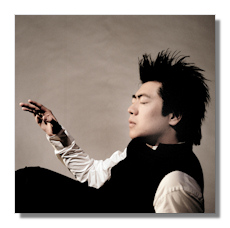
The Internet's Premier Classical Music Source
Related Links
- Latest Reviews
- More Reviews
-
By Composer
-
Collections
DVD & Blu-ray
Books
Concert Reviews
Articles/Interviews
Software
Audio
Search Amazon
Recommended Links
Site News
 Concert Review
Concert Review
Mozart and Chopin in Lang Lang Style

- Wolfgang Mozart:
- Sonata #5 in G Major, KV 283
- Sonata #4 in B Flat Major, KV 282
- Sonata #8 in A minor, KV 310
- Frédéric Chopin:
- Ballade #1 in G minor, Op. 23
- Ballade #2 in F Major, Op. 38
- Ballade #3 in A Flat Major, Op. 47
- Ballade #4 in F minor, Op. 52
Lang Lang, piano
Brussels, Centre for Fine Arts, 2 April 2014
In a lenient mood one might welcome Lang Lang's interpretation of three Mozart sonatas as a virtuoso fantasy based on Mozart themes. Neither could you blame the Chinese star pianist for trying out different accents or adding an extra shade of color, perchance a discreet ornamentation. After he casually walked to his piano in a packed Centre for fine Arts in Brussels, cheerfully picking out people in the front rows like he recognized old friends – a nod here, a wave there – he started the early sonatas as if in an improvisatory manner. There is no doubt his enthusiasm for playing the piano is highly infectious and one can understand the picturesque fascination.
Unfortunately, his manner is anything but subtle. Lang doesn't demand your attention; he slaps you in the face. For the horizontal lines he didn't care much – his suspended phrasing and frequent overlong interruptions smothered about every trace of melodic line. He rather preferred to pile up sounds, injecting the fast movements with palpitating rhythms and popup chords – and sometimes stamping feet to accompany the heat of the moment. Silky smooth alternated with bashed energy in both the 5th and 4th Sonatas. With the usual tics and mannerisms behind the keyboard thrown in (a raised forefinger to mark an important moment, or these stares towards the audience), it's a shock treatment to keep everybody awake – except for that loudly snoring man across the aisle, for whom the day clearly had been too long). Or perhaps Lang doesn't think his public is very intelligent but is prepared to buy anything he sells. And he might have a point. After the short KV 282 Sonata, which was only notable as an example of how far you can go in disrupting minuets, he immediately launched into the different world of the dramatic KV 310. The brilliantly executed but eventually shallow first movement was greeted with a full-house applause, as if he had ended a sonata – a new one in this case, with four movements. Intentional or not, but somebody had made his point. The Andante cantabile con espressione that followed was ponderously slow and contrasted with a manic last movement. One can be lenient, but even then there are limits.
While matters of style and understanding affected Lang's Mozart, his traversal of the Chopin Ballades suffered foremost from a lack of structure. As in the Mozart, overtly brilliant moments alternated with despairingly unconvincing ones, and the overall impression was one of bland showiness rather than emotional profundity. Contrasts in dynamics and tempi were similarly outsized in all four Ballades, giving them an unwarranted feel of monotony.
Lang started strongly with the 1st Ballade but the central section meandered along after which the jaw-dropping virtuosity displayed during the Presto con fuoco coda seemed gratuitous – and we now know Chopin wasn't kidding when he noted il più forte possibile. As could be expected, he captured the abruptly changing mood in the 2nd Ballade rather well, which came out as the most finished of the set. The 3rd however was torn apart while the complexities of the 4th seemed to elude him. All sense of movement was countered by his drawn out phrasing and pauses. In the end it was not the originality of Chopin's writing which caught our attention; it was Lang's oddball treatment of it. Not that his fans were disappointed. They gave him a standing ovation. Enough for Lang to thank them with an encore of a Chinese Seaweed Dance.
Copyright © 2014, Marc Haegeman












